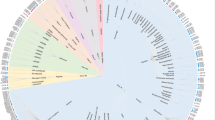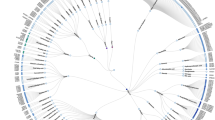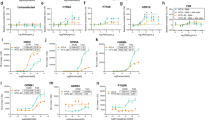Abstract
Although a plurality of drugs target G-protein-coupled receptors (GPCRs), most have emerged from classical medicinal chemistry and pharmacology programs and resemble one another structurally and functionally. Though effective, these drugs are often promiscuous. With the realization that GPCRs signal via multiple pathways, and with the emergence of crystal structures for this family of proteins, there is an opportunity to target GPCRs with new chemotypes and confer new signaling modalities. We consider structure-based and physical screening methods that have led to the discovery of new reagents, focusing particularly on the former. We illustrate their use against previously untargeted or orphan GPCRs, against allosteric sites, and against classical orthosteric sites that selectively activate one downstream pathway over others. The ligands that emerge are often chemically novel, which can lead to new biological effects.
This is a preview of subscription content, access via your institution
Access options
Access Nature and 54 other Nature Portfolio journals
Get Nature+, our best-value online-access subscription
$29.99 / 30 days
cancel any time
Subscribe to this journal
Receive 12 print issues and online access
$259.00 per year
only $21.58 per issue
Buy this article
- Purchase on Springer Link
- Instant access to full article PDF
Prices may be subject to local taxes which are calculated during checkout





Similar content being viewed by others
References
Dixon, R.A. et al. Cloning of the gene and cDNA for mammalian β-adrenergic receptor and homology with rhodopsin. Nature 321, 75–79 (1986). This paper closed the curtains on classical pharmacology, ushering in its molecular era.
Mason, J.S., Bortolato, A., Congreve, M. & Marshall, F.H. New insights from structural biology into the druggability of G protein-coupled receptors. Trends Pharmacol. Sci. 33, 249–260 (2012).
Roth, B.L., Sheffler, D.J. & Kroeze, W.K. Magic shotguns versus magic bullets: selectively non-selective drugs for mood disorders and schizophrenia. Nat. Rev. Drug Discov. 3, 353–359 (2004).
Hopkins, A.L. Network pharmacology: the next paradigm in drug discovery. Nat. Chem. Biol. 4, 682–690 (2008).
DeWire, S.M., Ahn, S., Lefkowitz, R.J. & Shenoy, S.K. β-arrestins and cell signaling. Annu. Rev. Physiol. 69, 483–510 (2007).
Rosenbaum, D.M. et al. GPCR engineering yields high-resolution structural insights into beta2-adrenergic receptor function. Science 318, 1266–1273 (2007). This paper begins GPCR pharmacology and ligand discovery at atomic resolution.
Kenakin, T.P. Biased signalling and allosteric machines: new vistas and challenges for drug discovery. Br. J. Pharmacol. 165, 1659–1669 (2012).
Latorraca, N.R., Venkatakrishnan, A.J. & Dror, R.O. GPCR dynamics: structures in motion. Chem. Rev. 117, 139–155 (2017). A seminal review on GPCR molecular dynamics simulations and what we can and cannot infer from them.
Irwin, J.J. & Shoichet, B.K. Docking screens for novel ligands conferring new biology. J. Med. Chem. 59, 4103–4120 (2016).
Hert, J., Irwin, J.J., Laggner, C., Keiser, M.J. & Shoichet, B.K. Quantifying biogenic bias in screening libraries. Nat. Chem. Biol. 5, 479–483 (2009).
Powers, R.A., Morandi, F. & Shoichet, B.K. Structure-based discovery of a novel, noncovalent inhibitor of AmpC β-lactamase. Structure 10, 1013–1023 (2002).
Doman, T.N. et al. Molecular docking and high-throughput screening for novel inhibitors of protein tyrosine phosphatase-1B. J. Med. Chem. 45, 2213–2221 (2002).
Grüneberg, S., Wendt, B. & Klebe, G. Subnanomolar inhibitors from computer screening: a model study using human carbonic anhydrase II. Angew. Chem. Int. Edn Engl. 40, 389–393 (2001).
Evers, A. & Klebe, G. Ligand-supported homology modeling of g-protein-coupled receptor sites: models sufficient for successful virtual screening. Angew. Chem. Int. Edn Engl. 43, 248–251 (2004).
Schapira, M., Abagyan, R. & Totrov, M. Nuclear hormone receptor targeted virtual screening. J. Med. Chem. 46, 3045–3059 (2003).
Hermann, J.C. et al. Structure-based activity prediction for an enzyme of unknown function. Nature 448, 775–779 (2007).
Teotico, D.G. et al. Docking for fragment inhibitors of AmpC β-lactamase. Proc. Natl. Acad. Sci. USA 106, 7455–7460 (2009).
Chen, Y. & Shoichet, B.K. Molecular docking and ligand specificity in fragment-based inhibitor discovery. Nat. Chem. Biol. 5, 358–364 (2009).
Rodríguez, D., Ranganathan, A. & Carlsson, J. Discovery of GPCR ligands by molecular docking screening: novel opportunities provided by crystal structures. Curr. Top. Med. Chem. 15, 2484–2503 (2015).
Wootten, D., Christopoulos, A. & Sexton, P.M. Emerging paradigms in GPCR allostery: implications for drug discovery. Nat. Rev. Drug Discov. 12, 630–644 (2013).
Neubig, R.R., Spedding, M., Kenakin, T. & Christopoulos, A. International union of pharmacology committee on receptor nomenclature and drug classification. XXXVIII. Update on terms and symbols in quantitative pharmacology. Pharmacol. Rev. 55, 597–606 (2003).
Pert, C.B., Pasternak, G. & Snyder, S.H. Opiate agonists and antagonists discriminated by receptor binding in brain. Science 182, 1359–1361 (1973).
Fenalti, G. et al. Molecular control of δ-opioid receptor signalling. Nature 506, 191–196 (2014).
Liu, W. et al. Structural basis for allosteric regulation of GPCRs by sodium ions. Science 337, 232–236 (2012). The first direct structural evidence for a GPCR allosteric modulator.
Garcia-Barrantes, P.M. et al. Lead optimization of the VU0486321 series of mGlu1 PAMs. Part 1: SAR of modifications to the central aryl core. Bioorg. Med. Chem. Lett. 25, 5107–5110 (2015).
Wang, C. et al. Structure of the human smoothened receptor bound to an antitumour agent. Nature 497, 338–343 (2013).
Kruse, A.C. et al. Structure and dynamics of the M3 muscarinic acetylcholine receptor. Nature 482, 552–556 (2012).
Thal, D.M. et al. Crystal structures of the M1 and M4 muscarinic acetylcholine receptors. Nature 531, 335–340 (2016). From the structures of two muscarinic receptors, the difficulties in generating selective orthosteric ligands for the family are highlighted.
Nickols, H.H. & Conn, P.J. Development of allosteric modulators of GPCRs for treatment of CNS disorders. Neurobiol. Dis. 61, 55–71 (2014).
Ahn, S. et al. Allosteric “beta-blocker” isolated from a DNA-encoded small molecule library. Proc. Natl. Acad. Sci. USA 114, 1708–1713 (2017).
Oswald, C. et al. Intracellular allosteric antagonism of the CCR9 receptor. Nature 540, 462–465 (2016).
Zheng, Y. et al. Structure of CC chemokine receptor 2 with orthosteric and allosteric antagonists. Nature 540, 458–461 (2016).
Cheng, R.K.Y. et al. Structural insight into allosteric modulation of protease-activated receptor 2. Nature 545, 112–115 (2017).
Lu, J. et al. Structural basis for the cooperative allosteric activation of the free fatty acid receptor GPR40. Nat. Struct. Mol. Biol. 24, 570–577 (2017).
Roth, B.L. & Chuang, D.M. Multiple mechanisms of serotonergic signal transduction. Life Sci. 41, 1051–1064 (1987).
Urban, J.D. et al. Functional selectivity and classical concepts of quantitative pharmacology. J. Pharmacol. Exp. Ther. 320, 1–13 (2007). Crystallization of the concept of GPCR functional selectivity and biased signaling.
Whistler, J.L. & von Zastrow, M. Morphine-activated opioid receptors elude desensitization by β-arrestin. Proc. Natl. Acad. Sci. USA 95, 9914–9919 (1998). One of the first demonstrations that drugs may differ in their degree of G-protein and arrestin bias, along with its functional consequences.
Xiao, R.P., Ji, X. & Lakatta, E.G. Functional coupling of the β 2-adrenoceptor to a pertussis toxin-sensitive G protein in cardiac myocytes. Mol. Pharmacol. 47, 322–329 (1995).
Masuho, I. et al. Distinct profiles of functional discrimination among G proteins determine the actions of G protein-coupled receptors. Sci. Signal. 8, ra123 (2015).
Kroeze, W.K. et al. PRESTO-Tango as an open-source resource for interrogation of the druggable human GPCRome. Nat. Struct. Mol. Biol. 22, 362–369 (2015).
Carlsson, J. et al. Ligand discovery from a dopamine D3 receptor homology model and crystal structure. Nat. Chem. Biol. 7, 769–778 (2011).
Allen, J.A. et al. Discovery of β-arrestin-biased dopamine D2 ligands for probing signal transduction pathways essential for antipsychotic efficacy. Proc. Natl. Acad. Sci. USA 108, 18488–18493 (2011).
Wacker, D. et al. Structural features for functional selectivity at serotonin receptors. Science 340, 615–619 (2013).
Lansu, K. et al. In silico design of novel probes for the atypical opioid receptor MRGPRX2. Nat. Chem. Biol. 13, 529–536 (2017).
Huang, X.P. et al. Allosteric ligands for the pharmacologically dark receptors GPR68 and GPR65. Nature 527, 477–483 (2015). Combination of physical screening with modeling and docking to discover ligands for orphan GPCRs, using the probe molecules that emerge to illuminate in vivo function.
Roth, B.L. DREADDs for neuroscientists. Neuron 89, 683–694 (2016).
Wess, J., Nakajima, K. & Jain, S. Novel designer receptors to probe GPCR signaling and physiology. Trends Pharmacol. Sci. 34, 385–392 (2013).
Lee, M.H. et al. The conformational signature of β-arrestin2 predicts its trafficking and signalling functions. Nature 531, 665–668 (2016).
Wells, J.A. & McClendon, C.L. Reaching for high-hanging fruit in drug discovery at protein-protein interfaces. Nature 450, 1001–1009 (2007).
Tan, Q. et al. Structure of the CCR5 chemokine receptor-HIV entry inhibitor maraviroc complex. Science 341, 1387–1390 (2013).
Foord, S.M. et al. International Union of Pharmacology. XLVI. G protein-coupled receptor list. Pharmacol. Rev. 57, 279–288 (2005).
Taipale, J. & Beachy, P.A. The Hedgehog and Wnt signalling pathways in cancer. Nature 411, 349–354 (2001).
Robarge, K.D. et al. GDC-0449-a potent inhibitor of the hedgehog pathway. Bioorg. Med. Chem. Lett. 19, 5576–5581 (2009).
Yauch, R.L. et al. Smoothened mutation confers resistance to a Hedgehog pathway inhibitor in medulloblastoma. Science 326, 572–574 (2009).
Wang, C. et al. Structural basis for Smoothened receptor modulation and chemoresistance to anticancer drugs. Nat. Commun. 5, 4355 (2014).
Lacroix, C. et al. Identification of novel smoothened ligands using structure-based docking. PLoS One 11, e0160365 (2016).
Sharpe, H.J., Wang, W., Hannoush, R.N. & de Sauvage, F.J. Regulation of the oncoprotein Smoothened by small molecules. Nat. Chem. Biol. 11, 246–255 (2015).
Roth, B.L. & Kroeze, W.K. Integrated approaches for genome-wide interrogation of the druggable non-olfactory G protein-coupled receptor superfamily. J. Biol. Chem. 290, 19471–19477 (2015).
Sterling, T. & Irwin, J.J. ZINC 15—ligand discovery for everyone. J. Chem. Inf. Model. 55, 2324–2337 (2015).
Yanai, T. et al. Identification and molecular docking studies for novel inverse agonists of SREB, super conserved receptor expressed in brain. Genes Cells 21, 717–727 (2016).
Wardman, J.H. et al. Identification of a small-molecule ligand that activates the neuropeptide receptor GPR171 and increases food intake. Sci. Signal. 9, ra55 (2016).
Ngo, T. et al. Orphan receptor ligand discovery by pickpocketing pharmacological neighbors. Nat. Chem. Biol. 13, 235–242 (2017).
Gloriam, D.E., Foord, S.M., Blaney, F.E. & Garland, S.L. Definition of the G protein-coupled receptor transmembrane bundle binding pocket and calculation of receptor similarities for drug design. J. Med. Chem. 52, 4429–4442 (2009).
Munk, C., Harpsøe, K., Hauser, A.S., Isberg, V. & Gloriam, D.E. Integrating structural and mutagenesis data to elucidate GPCR ligand binding. Curr. Opin. Pharmacol. 30, 51–58 (2016).
Shehata, M.A. et al. Novel agonist bioisosteres and common structure-activity relationships for the orphan G protein-coupled receptor GPR139. Sci. Rep. 6, 36681 (2016).
Bassilana, F. et al. Target identification for a Hedgehog pathway inhibitor reveals the receptor GPR39. Nat. Chem. Biol. 10, 343–349 (2014).
Christopoulos, A., Lanzafame, A. & Mitchelson, F. Allosteric interactions at muscarinic cholinoceptors. Clin. Exp. Pharmacol. Physiol. 25, 185–194 (1998).
Shirey, J.K. et al. An allosteric potentiator of M4 mAChR modulates hippocampal synaptic transmission. Nat. Chem. Biol. 4, 42–50 (2008).
Gould, R.W. et al. State-dependent alterations in sleep/wake architecture elicited by the M4 PAM VU0467154 - Relation to antipsychotic-like drug effects. Neuropharmacology 102, 244–253 (2016).
Ghoshal, A. et al. Potentiation of M1 muscarinic receptor reverses plasticity deficits and negative and cognitive symptoms in a schizophrenia mouse model. Neuropsychopharmacology 41, 598–610 (2016).
Besnard, J. et al. Automated design of ligands to polypharmacological profiles. Nature 492, 215–220 (2012).
Bridges, T.M. et al. Chemical lead optimization of a pan Gq mAChR M1, M3, M5 positive allosteric modulator (PAM) lead. Part II: development of a potent and highly selective M1 PAM. Bioorg. Med. Chem. Lett. 20, 1972–1975 (2010).
Blaney, J.M., Hansch, C., Silipo, C. & Vittoria, A. Structure-activity relationships of dihydrofolate reductase inhibitors. Chem. Rev. 84, 333–407 (1984).
Pinto, D.J. et al. Discovery of 1-(4-methoxyphenyl)-7-oxo-6-(4-(2-oxopiperidin-1-yl)phenyl)-4,5,6,7-tetrahydro-1H-pyrazolo[3,4-c]pyridine-3-carboxamide (apixaban, BMS-562247), a highly potent, selective, efficacious, and orally bioavailable inhibitor of blood coagulation factor Xa. J. Med. Chem. 50, 5339–5356 (2007).
Kolb, P. et al. Structure-based discovery of β2-adrenergic receptor ligands. Proc. Natl. Acad. Sci. USA 106, 6843–6848 (2009).
Kruse, A.C. et al. Muscarinic receptors as model targets and antitargets for structure-based ligand discovery. Mol. Pharmacol. 84, 528–540 (2013).
Kaczor, A.A. et al. Structure-based virtual screening for dopamine D2 receptor ligands as potential antipsychotics. ChemMedChem 11, 718–729 (2016).
Barelier, S., Sterling, T., O'Meara, M.J. & Shoichet, B.K. The recognition of identical ligands by unrelated proteins. ACS Chem. Biol. 10, 2772–2784 (2015).
Bohn, L.M., Gainetdinov, R.R., Lin, F.T., Lefkowitz, R.J. & Caron, M.G. μ-opioid receptor desensitization by β-arrestin-2 determines morphine tolerance but not dependence. Nature 408, 720–723 (2000). The first paper to demonstrate that arrestin signaling may have in vivo consequences relevant to drug actions.
DeWire, S.M. et al. A G protein-biased ligand at the μ-opioid receptor is potently analgesic with reduced gastrointestinal and respiratory dysfunction compared with morphine. J. Pharmacol. Exp. Ther. 344, 708–717 (2013).
Manglik, A. et al. Crystal structure of the μ-opioid receptor bound to a morphinan antagonist. Nature 485, 321–326 (2012).
Manglik, A. et al. Structure-based discovery of opioid analgesics with reduced side effects. Nature 537, 185–190 (2016). A recent success for structure-based discovery, leading to chemically novel agonists for the μ-opioid receptor. The novelty of the chemotype was echoed in new biological activities.
Broom, D.C. et al. Comparison of receptor mechanisms and efficacy requirements for delta-agonist-induced convulsive activity and antinociception in mice. J. Pharmacol. Exp. Ther. 303, 723–729 (2002).
Boerrigter, G. et al. Cardiorenal actions of TRV120027, a novel β-arrestin-biased ligand at the angiotensin II type I receptor, in healthy and heart failure canines: a novel therapeutic strategy for acute heart failure. Circ Heart Fail 4, 770–778 (2011).
Chen, X. et al. Structure-functional selectivity relationship studies of β-arrestin-biased dopamine D2 receptor agonists. J. Med. Chem. 55, 7141–7153 (2012).
Morgenweck, J., Frankowski, K.J., Prisinzano, T.E., Aubé, J. & Bohn, L.M. Investigation of the role of βarrestin2 in kappa opioid receptor modulation in a mouse model of pruritus. Neuropharmacology 99, 600–609 (2015).
White, K.L. et al. The G protein-biased κ-opioid receptor agonist RB-64 is analgesic with a unique spectrum of activities in vivo. J. Pharmacol. Exp. Ther. 352, 98–109 (2015).
Conroy, J.L., Free, R.B. & Sibley, D.R. Identification of G protein-biased agonists that fail to recruit β-arrestin or promote internalization of the D1 dopamine receptor. ACS Chem. Neurosci. 6, 681–692 (2015).
Yadav, P.N., Kroeze, W.K., Farrell, M.S. & Roth, B.L. Antagonist functional selectivity: 5-HT2A serotonin receptor antagonists differentially regulate 5-HT2A receptor protein level in vivo. J. Pharmacol. Exp. Ther. 339, 99–105 (2011).
Schmid, C.L., Streicher, J.M., Meltzer, H.Y. & Bohn, L.M. Clozapine acts as an agonist at serotonin 2A receptors to counter MK-801-induced behaviors through a βarrestin2-independent activation of Akt. Neuropsychopharmacology 39, 1902–1913 (2014).
Marion, S., Weiner, D.M. & Caron, M.G. RNA editing induces variation in desensitization and trafficking of 5-hydroxytryptamine 2c receptor isoforms. J. Biol. Chem. 279, 2945–2954 (2004).
Clarke, W.P., Chavera, T.A., Silva, M., Sullivan, L.C. & Berg, K.A. Signalling profile differences: paliperidone versus risperidone. Br. J. Pharmacol. 170, 532–545 (2013).
Canal, C.E. et al. Molecular pharmacology and ligand docking studies reveal a single amino acid difference between mouse and human serotonin 5-HT2A receptors that impacts behavioral translation of novel 4-phenyl-2-dimethylaminotetralin ligands. J. Pharmacol. Exp. Ther. 347, 705–716 (2013).
de Graaf, C. et al. Crystal structure-based virtual screening for fragment-like ligands of the human histamine H1 receptor. J. Med. Chem. 54, 8195–8206 (2011).
Wacker, D. et al. Conserved binding mode of human β2 adrenergic receptor inverse agonists and antagonist revealed by X-ray crystallography. J. Am. Chem. Soc. 132, 11443–11445 (2010).
Katritch, V. et al. Structure-based discovery of novel chemotypes for adenosine A2A receptor antagonists. J. Med. Chem. 53, 1799–1809 (2010).
Carlsson, J. et al. Structure-based discovery of A2A adenosine receptor ligands. J. Med. Chem. 53, 3748–3755 (2010).
Lane, J.R. et al. Structure-based ligand discovery targeting orthosteric and allosteric pockets of dopamine receptors. Mol. Pharmacol. 84, 794–807 (2013).
Jang, J.W. et al. Novel scaffold identification of mGlu1 receptor negative allosteric modulators using a hierarchical virtual screening approach. Chem. Biol. Drug Des. 87, 239–256 (2016).
Vass, M. et al. Dynamics and structural determinants of ligand recognition of the 5-HT6 receptor. J. Comput. Aided Mol. Des. 29, 1137–1149 (2015).
Kiss, R. & Keseru, G.M. Novel histamine H4 receptor ligands and their potential therapeutic applications: an update. Expert Opin. Ther. Pat. 24, 1185–1197 (2014).
Kolb, P. et al. Limits of ligand selectivity from docking to models: in silico screening for A(1) adenosine receptor antagonists. PLoS One 7, e49910 (2012).
Negri, A. et al. Discovery of a novel selective kappa-opioid receptor agonist using crystal structure-based virtual screening. J. Chem. Inf. Model. 53, 521–526 (2013).
Keiser, M.J. et al. Relating protein pharmacology by ligand chemistry. Nat. Biotechnol. 25, 197–206 (2007).
Huang, X.P. et al. Parallel functional activity profiling reveals valvulopathogens are potent 5-hydroxytryptamine2B receptor agonists: implications for drug safety assessment. Mol. Pharmacol. 76, 710–722 (2009).
Acknowledgements
Support was given by NIH grants U01104974, and R35GM122481, and the NIMH-PDSP. We thank T. Kenakin for discussions of allostery, J. Pottel and A. Levit for reading this manuscript, and the latter for chemoinformatic assistance.
Author information
Authors and Affiliations
Corresponding authors
Ethics declarations
Competing interests
B.K.S. and B.L.R. are co-founders of Epiodyne, a GPCR ligand discovery company. B.K.S. and J.J.I. are co-founders of Blue Dolphin, a library docking CRO.
Rights and permissions
About this article
Cite this article
Roth, B., Irwin, J. & Shoichet, B. Discovery of new GPCR ligands to illuminate new biology. Nat Chem Biol 13, 1143–1151 (2017). https://doi.org/10.1038/nchembio.2490
Received:
Accepted:
Published:
Issue Date:
DOI: https://doi.org/10.1038/nchembio.2490
This article is cited by
-
Prediction of dynamic allostery for the transmembrane domain of the sweet taste receptor subunit, TAS1R3
Communications Biology (2023)
-
AlphaFold2 versus experimental structures: evaluation on G protein-coupled receptors
Acta Pharmacologica Sinica (2023)
-
Structural studies of phosphorylation-dependent interactions between the V2R receptor and arrestin-2
Nature Communications (2021)
-
Structure of the dopamine D2 receptor in complex with the antipsychotic drug spiperone
Nature Communications (2020)
-
Nanobody-enabled monitoring of kappa opioid receptor states
Nature Communications (2020)



